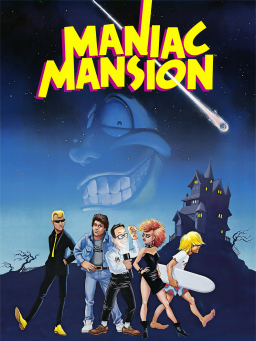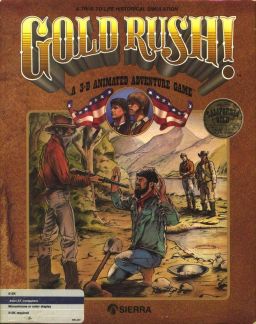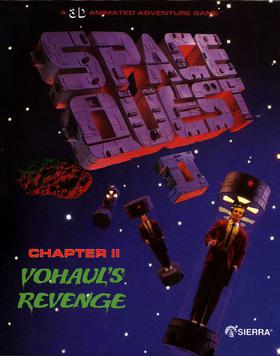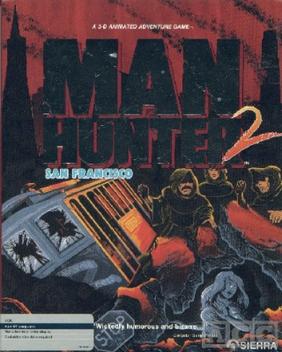
Maniac Mansion is a 1987 graphic adventure video game developed and published by Lucasfilm Games. It follows teenage protagonist Dave Miller as he attempts to rescue his girlfriend Sandy Pantz from a mad scientist, whose mind has been enslaved by a sentient meteor. The player uses a point-and-click interface to guide Dave and two of his six playable friends through the scientist's mansion while solving puzzles and avoiding dangers. Gameplay is non-linear, and the game must be completed in different ways based on the player's choice of characters. Initially released for the Commodore 64 and Apple II, Maniac Mansion was Lucasfilm Games' first self-published product.

Script Creation Utility for Maniac Mansion Virtual Machine (ScummVM) is a set of game engine recreations. Originally designed to play LucasArts adventure games that use the SCUMM system, it also supports a variety of non-SCUMM games by companies like Revolution Software and Adventure Soft. It was originally written by Ludvig Strigeus. Released under the terms of the GNU General Public License, ScummVM is free software.

King's Quest is a graphic adventure game series, released between 1980 and 2016 and created by the American software company Sierra Entertainment. It is widely considered a classic series from the golden era of adventure games. Following the success of its first installments, the series was primarily responsible for building the reputation of Sierra. Roberta Williams, co-founder and former co-owner of Sierra, designed all of the King's Quest games until the series' reboot in 2015.

From the late 1980s to the early 2000s, LucasArts was well known for their point-and-click graphic adventure games, nearly all of which received high scoring reviews at the time of their release. Their style tended towards the humorous, often irreverent or slapstick humor, with the exceptions of Loom and The Dig. Their game design philosophy was that the player should never die or reach a complete dead-end, although there were exceptions.
The Adventure Game Interpreter (AGI) is a game engine developed by Sierra On-Line. The company originally developed the engine for King's Quest (1984), an adventure game which Sierra and IBM wished to market in order to attract consumers to IBM's lower-cost home computer, the IBM PCjr.
Manhunter or Man Hunter may refer to:

King's Quest is an adventure game developed by Sierra On-Line and published originally for the IBM PCjr in 1984 and later for several other systems between 1984 and 1989. The game was originally titled King's Quest; the subtitle Quest for the Crown was added to the game box in the 1987 re-release, but did not appear in the game.

King's Quest II: Romancing the Throne is the second installment in the King's Quest series of graphic adventure games by Sierra On-Line. It was originally released in 1985 for PC DOS/PCjr, and later made available for the Apple II/IIGS, Atari ST, and Amiga. It uses the same AGI game engine as King's Quest I: Quest for the Crown and features King Graham as the player character. The title is a spoof of the 1984 film Romancing the Stone.

King's Quest III: To Heir Is Human is the third installment in the King's Quest series of graphic adventure games developed and released by Sierra On-Line in 1986. The game was originally released for the Apple II and PC DOS, and later ported to several other computer systems. It was the first title game in the series not to feature King Graham as the player character.

King's Quest IV: The Perils of Rosella is a graphic adventure game developed and released by Sierra On-Line for the MS-DOS, Amiga, Apple II, Apple IIGS, and Atari ST computers in 1988. The player takes on the role of Princess Rosella, daughter of King Graham of Daventry and the twin sister of Gwydion/Alexander, who must save her father and a good fairy and destroy an evil witch. Critically acclaimed, it was one of the first PC games to support a sound card.

BattleTech: The Crescent Hawk's Inception is a turn-based adventure/role-playing video game released in 1988 by Westwood Associates and based on the BattleTech franchise. It was one of the first commercial ports of the licence, and featured some of the franchise's worlds, institutions, political figures, and weapons, particularly the three-story tall BattleMechs. It was followed by a sequel, BattleTech: The Crescent Hawk's Revenge, though that game featured significantly different gameplay, falling into the real-time tactics genre rather than adventure/role-playing.

Gold Rush! is a graphic adventure video game designed by Doug and Ken MacNeill and originally released by Sierra On-Line in 1988.

Leisure Suit Larry in the Land of the Lounge Lizards is a graphic adventure game, developed by Sierra On-Line, and published in 1987. It was developed for the PC, DOS, and the Apple II and later ported to other platforms, such as the Amiga, Atari ST, Apple IIGS, Macintosh, and Tandy Color Computer 3. It utilizes the Adventure Game Interpreter (AGI) engine. In 1991, Sierra released a remake titled Leisure Suit Larry 1: In the Land of the Lounge Lizards for PC DOS, Apple Macintosh, and Amiga. This version used the Sierra's Creative Interpreter (SCI) engine, featuring 256 colors and a point-and-click, icon-driven user interface.

Space Quest: Chapter I – The Sarien Encounter, commonly known as Space Quest I, is a graphic adventure game released in October 1986 by Sierra On-Line. It is the first game in the Space Quest series. It quickly became a hit, selling in excess of 100,000 copies. Total sales are believed to be around 200,000 to date, not including the many compilations it has been included in.

Space Quest II: Chapter II – Vohaul's Revenge, commonly known as Space Quest II: Vohaul's Revenge, is a graphic adventure game released on November 14, 1987 by Sierra On-Line. It was the sequel to Space Quest I: The Sarien Encounter, again using Sierra's AGI game engine.

Manhunter 2: San Francisco is a post-apocalyptic adventure game designed by Barry Murry, Dave Murry, and Dee Dee Murry of Evryware and published in 1989 by Sierra On-Line. It is the sequel to Manhunter: New York, developed by the same authors.

Police Quest: In Pursuit of the Death Angel is a 1987 police procedural adventure video game developed and published by Jim Walls and Sierra On-Line. Police Quest follows police officer Sonny Bonds as he investigates a drug cartel in the town of Lytton, California.
There have been several King's Quest fangames both original and retellings/remakes of the original games that have been released by various developers.

Sierra Championship Boxing is a boxing video game developed by Evryware and published by Sierra On-Line in 1983. Versions were released for Apple II, Commodore 64, IBM PC compatibles, and Macintosh.
















